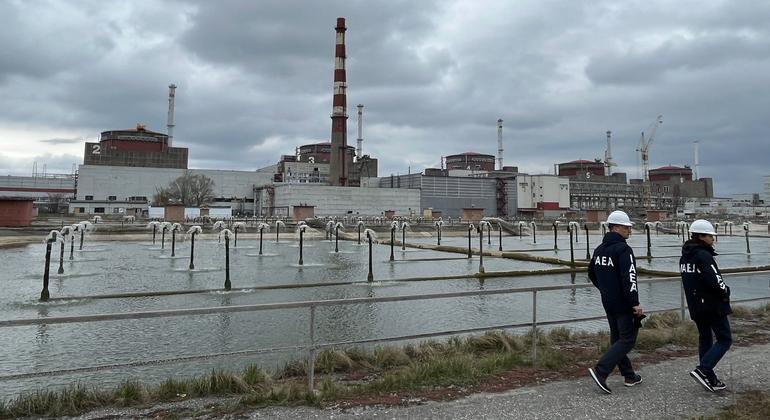The purpose of placing reactor unit 4 in cold shutdown is to investigate the exact cause of the leak and carry out necessary maintenance to repair the affected steam generator, according to a statement by Rafael Mariano Grossi, IAEA Director General.
There was no radiological release to the environment, the statement noted, adding that over the next three days, the nuclear power plant will move unit 6 to hot shutdown to continue steam production.
Unit 6 had been in cold shutdown since 21 April to facilitate safety system inspections and maintenance.
“The IAEA team on the site will closely monitor the operations for the transition between the shutdown states of Units 4 and 6,” said Mr. Grossi.
Power challenges
The IAEA has been monitoring the situation at Europe’s largest nuclear power plant since the early days of the conflict. The ZNPP is controlled by Russian forces but operated by its Ukrainian staff.
Mr. Grossi reported that there were power disruptions on Thursday after the 750kV power line disconnected twice during the day.
The ZNPP had to rely on 330 kV backup line, to supply the electricity required, for example, to perform safety functions such as pumping cooling water for the plant; and there was no total loss of off-site power to the site and emergency diesel generators were not needed.
According to IAEA, the nuclear power plant has been experiencing major off-site power problems since the conflict began in February 2022, exacerbating the nuclear safety and security risks facing the site currently located on the frontline.
“The repeated power line cuts underline the continuing precarious nuclear safety and security situation at the plant,” Mr. Grossi said.
Availability of cooling water remains relatively stable, with measures to mitigate water loss from the cooling pond by pumping in water from the ZNPP inlet channel.
IAEA experts’ site inspections
IAEA experts at the nuclear power plant have also conducted multiple walkdowns in different parts of the site, including visits to spent fuel storage and reactor control rooms, the agency said.
In one of the visits, on Tuesday, to the main control room, emergency control room and other safety-related rooms, the team did not observe any mines or usual objects in the main control; but in the turbine hall of unit 2, they noted the presence of a number of military trucks parked in an area reserved for vehicle maintenance.
While the team did not observe mines or explosives in any new locations during the past week, they did confirm the presence of the mines previously observed on 23 July, IAEA added.
The experts were informed by ZNPP that a drone was spotted and intercepted near the city of Enerhodar on Wednesday, but confirmed it had no impact on the plant’s safety.
Meanwhile, IAEA teams at other Ukrainian nuclear power plants – Khmelnitsky, Rivne, and South Ukraine, as well as the Chornobyl site – reported air-raid alarms on Wednesday. They added that the safety and security at the facilities were not affected.
Attack targeting hotel in Zaporizhzhya
Also on Thursday, the UN Humanitarian Coordinator for Ukraine said that a hotel, frequently used by UN and Non-Governmental Organizations (NGOs) personnel was hit by a Russian strike in Zaporizhzhia.
“It is utterly inadmissible,” Denise Brown said.
“The number of indiscriminate attacks hitting civilian infrastructure, killing and injuring civilians, have reached unimaginable levels – these attacks violate international humanitarian law,” she added, calling on Russia to stop indiscriminate attacks.


